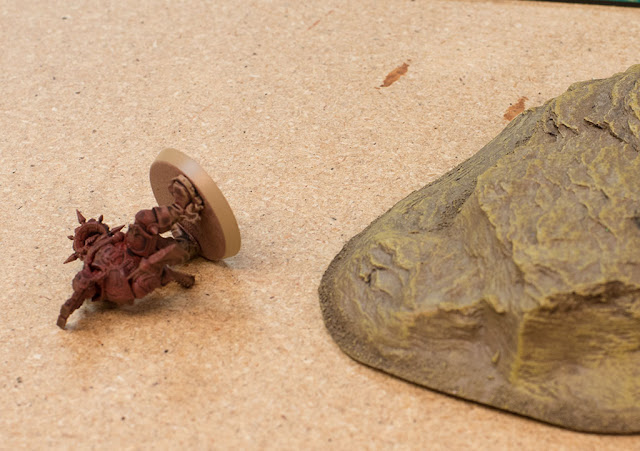Games Workshop bases. For better or worse, we're all used to them (or their many copy-cats). But while assembling my large order from Anvil Industry to make a copyright-legal army for WarStrike, I had to decide what kind of bases to use for the figures that didn't come with any.
And since I've got a nice 3D resin printer... Well, I think I've come up with something much better than the norm.
Custom Sizing
The first thing to do was to decide what size of base that I needed. For the Anvil Black Ops sniper model above, the old 25mm GW bases were too small. But the newer 32mm were just too big. So I opted for a custom 30mm base.
I also wanted this base to match the outer look of the GW bases everyone is familiar with, so I sloped the sides. If this model looks a bit thick, it's because I have to add one mm to the up-axis in order for the base to come out at the proper thickness of 3mm on my resin printer.
Flat Bottoms
On the SLP printer I have, the UV image is projected all at once, so the actual number of models being printed doesn't matter, just the overall height. So I can gang eight 30mm bases onto the print bed and it takes 26 minutes to print them. The same as for printing just one.
(Pro-Tip: Print the bases upside down, and it's much easier to remove them from the bed.)
Now one key thing here is that I decided to print the bases solid, with flat bottoms. This is good for two reasons. One, it gives more weight to the base. Each of these bases weighs 2.8 grams, while a similarly sized GW plastic base would weigh about 1.4 grams. Given the same weight of model, this means that the solid base would represent a much higher percentage of the model's weight, lowering its center of gravity.
For this test though, it's kind of a wash, as my resin Anvil sniper is about 2 grams heavier than a similarly sized GW plastic model. But put a plastic model on a heavier resin base and you'd see much more of a difference.
At the very least, it means that my resin model won't be any more top-heavy than a plastic model with a hollow base would be. And... I did make the base a little wider than it absolutely had to be, giving it more leverage in the tests that will follow.
But the second reason for the flat bottomed base is that I can glue velvet-textured paper to it. Much like you would see on the bottom of gaming counters, or Gale Force 9 terrain pieces (like the hill below). This VASTLY increases the surface friction of the base.
So what does this let me do with this model? Let's take a look...
Where a miniature on a hollowed-out plastic base would fall over, even on the easiest slopes...
My Anvil sniper stays right in place!
Let's try some more challenging sniper positions...
The rounded edge of a home-built hill.
On the flat part of that same hill, lifted up almost 30º. If the miniature was plastic I could probably have gotten this up to 40º - 45º.
On top of some model-unfriendly rubble.
At an angle against a terrain feature that would have been too wide (but not wide enough) to allow a hollow GW base to lay against it.
This Generator model, BTW, is from Printable Scenery. A company that sells 3D models of buildings for printing. They've got a new Kickstarter here, and I WANT those tele-portals! Plus it's only $64 for EVERYTHING on that page (go look, it's a lot). This company kicks ass, and the great thing is that as soon as the Kickstarter funds, most of the models become available immediately. So there's no Palladium-like risk of not getting what you paid for. I've funded two of their Kickstarters with no problems whatsoever.
This particular Printable Scenery model was printed on my new Lulzbot Taz6. A fused filament printer that has a bed big enough to make the whole thing in one go, instead of in parts. The printing took 19 hours to complete.
And finally, we have the Anvil sniper sitting on a smooth rock surface atop a pet store terrarium piece that I've been converting into a desert cave shelter. There's no way that any model with a standard base bottom would stay in place here. There just wouldn't be enough friction.
And of course if the surface has any roughness, the model stays in place real well. :)
Thoughts?











